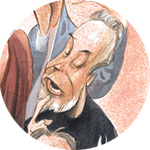 |
|
| Everybody's a critic
Michael Sorkin, AB’69 An architect and director of the graduate program in urban design at the City College of New York, Michael Sorkin is the former architecture critic for the Village Voice and has written for publications including Architectural Digest, Mother Jones, Vanity Fair, and the Wall Street Journal, tackling such thorny issues as the increasing homogenization of America’s cities and the University of Chicago’s master plan. Education. An Ideas and Methods concentrator at Chicago, Sorkin earned a master’s in English from Columbia University (1970) and a master’s in architecture from MIT (1973). Guiding lights. With a studio (Michael Sorkin Design) ten blocks from Ground Zero, he has kept an eagle eye on proposals for redeveloping the World Trade Center site and what those plans mean for life in New York City. From the first days after 9/11, he has argued that the reconstruction project offers an opportunity to respond to the needs of the whole city, a view consistent with his central beliefs about his discipline: “Architecture, by definition, is social,” he told the Magazine, “and fascinating for the meanings that inhere in it and the way in which it inevitably expresses relationships of power.” Turning point. A first-year course on Plato’s Republic was “my first real exposure to the close reading of a philosophical text. Perhaps equally bracing was the fact that the course met late in the afternoon during winter quarter and we were discharged into the quads after dark—incredibly romantic. There was a sublime continuity between the intellectual and the architectural experiences that has stuck with me, the idea that the life of the mind can be so enhanced by its setting.” The downside to his Chicago training? “I sometimes wish that I could throw off the burdens of analysis that have stuck with me since college and simply go with the flow of designing.” Lessons learned. “Critical discourse takes two,” Sorkin said, offering up as an example his experience when the University commissioned him in 1998 to design an alternative to the official architectural master plan: “One of the great disappointments of my involvement with the U of C master plan was the poverty of critical engagement and ambition on the part of the University. To have been dismissed from the process for having criticized it struck me as contrary to the spirit so pervasive and memorable during my College days.” Short list.
Variations on a Theme Park: The New American City and the End
of Public Spaces, editor (Hill & Wang, 1992); Other
Plans: University of Chicago Studies, 1998–2000 (Princeton
Architectural Press, 2001); The Next Jerusalem: Sharing the
Divided City, editor (Monicelli Press, 2002); Starting
from Zero: Reconstructing Downtown New York (Routledge, 2003).
|
|
phone: 773/702-2163 | fax: 773/702-8836 | uchicago-magazine@uchicago.edu

